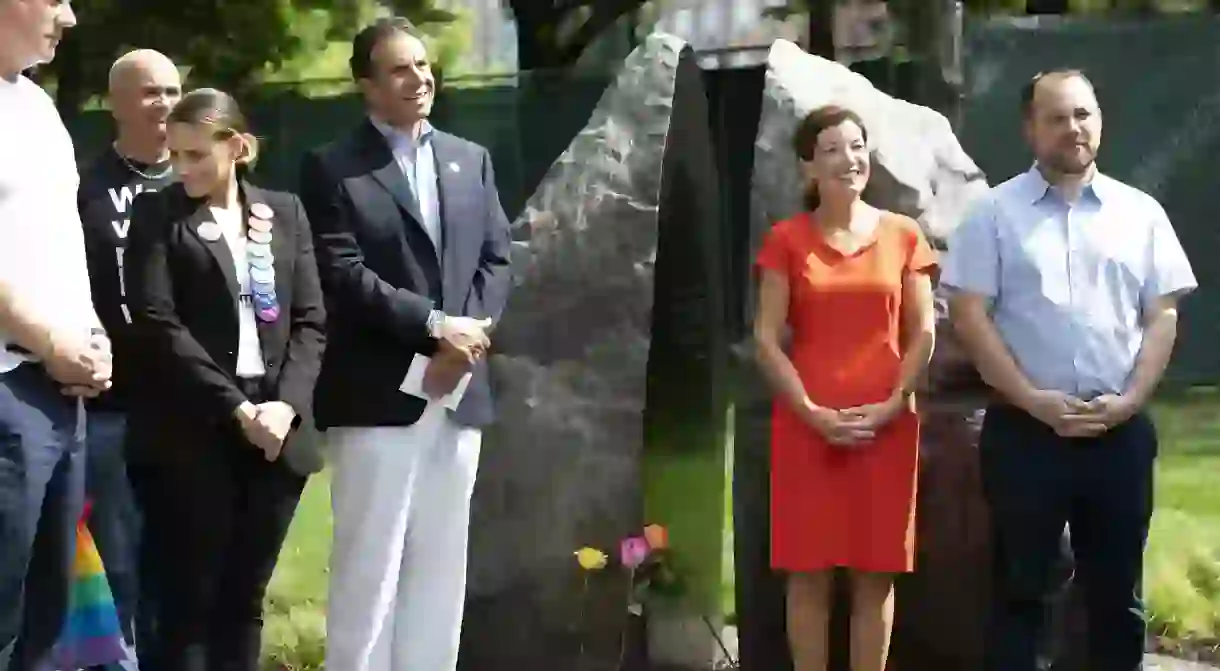How NYC’s First Official LGBTQ Monument Celebrates Community

On Sunday, June 24, 2018, New York City’s first LGBTQ monument debuted with the 49th Annual Pride March in full swing. Dedicated to the victims of the 2016 Orlando Pulse nightclub shooting, the memorial celebrates the queer community and commemorates the lives lost to the adversity it has faced.
Located close to the shore inside Hudson River Park between West 12th and Bethune Streets, the monument faces the Statue of Liberty and the Christopher Street Pier. Nine boulders sit in a circle, six of which are bisected with prismatic glass. The prisms cast rainbows that represent the joy and lightness that can be found in the community amidst intolerance and hatred.

Cuban-American artist Anthony Goicolea, commissioned to create the monument, described the experience of designing and installing the piece as an emotional one. “Growing up in Georgia as a gay Cuban boy in the ’70s really informed my work,” he told Culture Trip. “Being chosen to represent the LGBTQ community and asked to help pay homage to those lost in the Pulse nightclub shooting was a daunting task. I wanted to create something that was both respectful and somber, but also celebratory and beautiful. I felt the best way to do that was to provide an environment that reveals itself to the viewer differently each time.”
The memorial serves as a record of the community it engages. Inspired by the dolmens of Europe, pre-Columbian burial mounds, and Native American tribal spots, Goicolea cast the stones in a bronze that was made to simulate rough-hewn granite, a material traditionally used to mark burial sites. Over time, their surfaces will smooth as more people touch them.

“The horror of the Pulse nightclub shooting is forever etched in our collective memories, and this LGBTQ memorial will help ensure we honor the victims and keep in mind the ongoing struggle of the LGBTQ community,” Speaker Corey Johnson said at the unveiling. “I thank artist Anthony Goicolea for his beautiful design, and to Governor Andrew Cuomo and the LGBTQ Commission for driving this project to completion. Their work inspires us to keep fighting for full LGBTQ equality everywhere, and we will forever keep the victims of the Pulse tragedy in our hearts.”
The memorial also creates a sense of community within the public space of the park. The circular formation of the stones as a cove along the river “creates a safe harbor and invites people to sit on the stones,” Goicolea said. “Because it is a circle, any two or more people automatically form an impromptu community. They face inward and share the same space. They create a bond.”

The two largest stones of the circle do not contain any glass; instead, the insides are polished smooth where it’s been split, and engraved on each side are the following quotes from Audre Lorde, which Goicolea described as the “inner voice” of the memorial:
“Without community, there is no liberation… But community must not mean a shedding of our differences,” and “Difference is that raw and powerful connection from which our personal power is forged.”
Lorde’s quotes about the importance of community, and about honoring each other’s differences in order to strengthen both our individual selves and our communities, resonated with Goicolea. “It is hard to find language that can hold all those conflicting sentiments,” he said. “But I feel like the passage is perfect.”
Lorde’s words, then, function as both an epitaph and a warning that freedom (of expression, of love) requires the strength of a welcoming and diverse community. This sentiment is echoed in the physical space that the LGBTQ monument inhabits too—a hallowed roundtable of sorts, inviting all who pass through to have a seat at the table.













